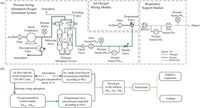A new ventilator prototype aims to revolutionize emergency medical care by providing stand-alone oxygenated respiratory support, thanks to a sophisticated oxygen generation system integrated within the device. Researchers in China have developed this innovative prototype, which combines a high-performance oil-free scroll compressor with a pressure swing adsorption (PSA) system to produce a steady flow of oxygen without the need for external infrastructure.
Current mechanical ventilators rely on wall outlets or oxygen cylinders, which restrict their functionality in critical situations such as on-site rescues or during patient transport. Acknowledging this limitation, the authors of the study sought to design a system that could deliver reliable respiratory assistance even in the most challenging conditions.
The new ventilator prototype showcases its ability to generate over 17 liters of oxygen per minute, with an oxygen concentration of 93% ± 3%. This capability marks a significant leap from existing mobile oxygen generators, which often struggle to achieve adequate flow rates and concentrations. Notably, the ventilator achieves a maximum non-invasive ventilation oxygen concentration of 58% ± 1.75% under settings commonly used in clinical practice, namely the BiPAP (bi-level positive airway pressure) parameters.
"The proposed oxygen generator integrated ventilator could provide reliable oxygenated respiratory support in emergencies," wrote the authors of the article. This system is particularly vital for emergency medical scenarios where quick response times are crucial, such as in military field operations and areas suffering from disaster conditions.
The heart of this ventilator lies in its advanced oxygen generation module, which supports both high oxygen flow and optimized respiratory synchronization. By regulating oxygen supply and tracking the patient’s respiratory state with quick response times—specifically achieving an inspiratory trigger delay time of less than 200 milliseconds—the ventilator enhances patient comfort while ensuring effective oxygen delivery.
The research team successfully improved the generator's output capacity by nearly 70%, indicating that the prototype can effectively meet the respiratory needs of critically ill patients. As the authors elaborated, "Satisfactory respiratory synchronization was realized with an inspiratory trigger delay time of less than 200 ms," ensuring that the ventilator's performance aligns well with that of patients who depend on it.
The mechanism relies on a meticulously designed oil-free scroll compressor, which boasts high efficiency, low noise, and reduced mechanical wear compared to traditional piston compressors. Additionally, the use of lithium-type zeolite molecular sieves within the PSA system enhances nitrogen adsorption, crucial for generating the high concentrations of oxygen needed for effective patient ventilation.
In terms of performance testing, volunteers engaged in evaluations showed that the ventilator could comfortably maintain an oxygen concentration target with minimal error. With controlled oxygen concentrations set to maintain consistent levels, the device exhibited fantastic stability, showcasing the potential for use in various medical emergencies.
This prototype stands to address ongoing challenges within emergency medical responses, such as accidents or natural disasters, where quick access to high-quality ventilatory support can be the difference between life and death. As noted by the researchers, "This integrated ventilator holds significant promise for treating critically ill patients in emergency medical rescue scenarios." Importantly, this innovation exemplifies a practical approach to enhancing medical support technology beyond conventional limitations.
In conclusion, the effective integration of an oxygen generator with a ventilator can reshape how respiratory support is delivered during emergencies, providing a path forward for deploying advanced medical care in settings that require immediacy and reliability. This groundbreaking approach not only highlights advancements in ventilation technology but also underscores the ongoing need for adaptable and efficient medical solutions in facing global health challenges.




